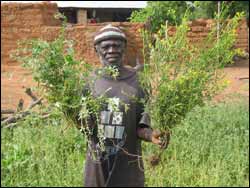Crime Scene Investigates: The Case of the Dead Cow

A typical Ghanaian peasant livestock farmer providing information on Cleome viscosa in his left hand, known to be poisonous to livestock and Cleome gynandra in his right hand, which is not poisonous but used as a vegetable among the indigenous people, supplied by Charles Domorozo
Dr Domozoro will describe how he uses plant DNA from the animal’s stomach for forensic fingerprinting on Thursday 6th April at the Society for Experimental Biology’s Annual Main Meeting, Canterbury [session P6]. “Knowing the offending plants will help us to manage the poisoning outbreak by targeting specific treatment routines or withdrawing livestock from infested pastures”, says Domozoro.
Since the identifying features of plants are rapidly digested in the stomach of herbivores it is often difficult to tell if and how an animal has been poisoned. Such misdiagnoses are costly to the agricultural industry and also mean that statistics on how widespread is poisoning are inaccurate. The practical application of this technique means that when a cow or sheep dies, if a sample of the rumen contents is taken within a day, it can be stored or used immediately to determine if plant poisoning was the cause of death.
Domozoro uses plant material, extracted from Ghanaian animals within 24 hours of death, as the template to amplify specific DNA sequences to give a plant-fingerprint: this is specific to the species of plant present in the animal’s rumen. Domozoro has affiliations with the Council for Scientific and Industrial Research in Ghana and so the first database he has used to search for a match consists of the known DNA sequences of ~40 poisonous Ghanaian plant species. This only represents a fraction of the known poisonous plants in Ghana and there is a need to keep expanding the database. The technique could be used to identify poisonous plants from any country as long as their DNA sequence is known: “The procedure can be applied anywhere, but the reference database will need to be carefully selected to include the geographical range”, explains Domozoro.
Media Contact
More Information:
http://www.sebiology.org.ukAll latest news from the category: Agricultural and Forestry Science
Newest articles

Long-sought structure of powerful anticancer natural product
…solved by integrated approach. A collaborative effort by the research groups of Professor Haruhiko Fuwa from Chuo University and Professor Masashi Tsuda from Kochi University has culminated in the structure…

Making a difference: Efficient water harvesting from air possible
Copolymer solution uses water-loving differential to induce desorption at lower temperatures. Harvesting water from the air and decreasing humidity are crucial to realizing a more comfortable life for humanity. Water-adsorption…

In major materials breakthrough
UVA team solves a nearly 200-year-old challenge in polymers. UVA researchers defy materials science rules with molecules that release stored length to decouple stiffness and stretchability. Researchers at the University…



